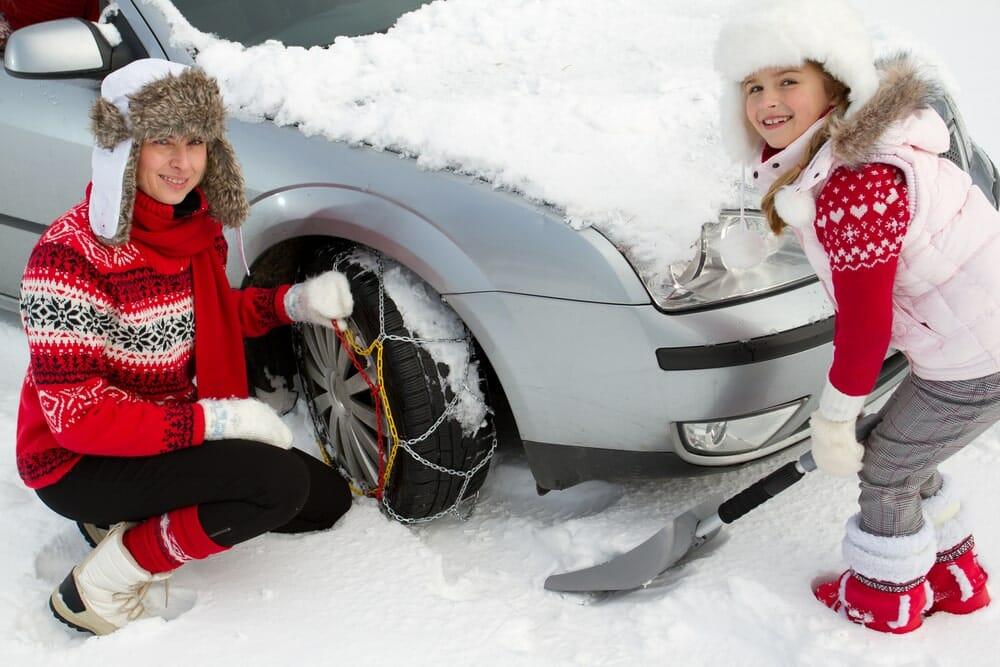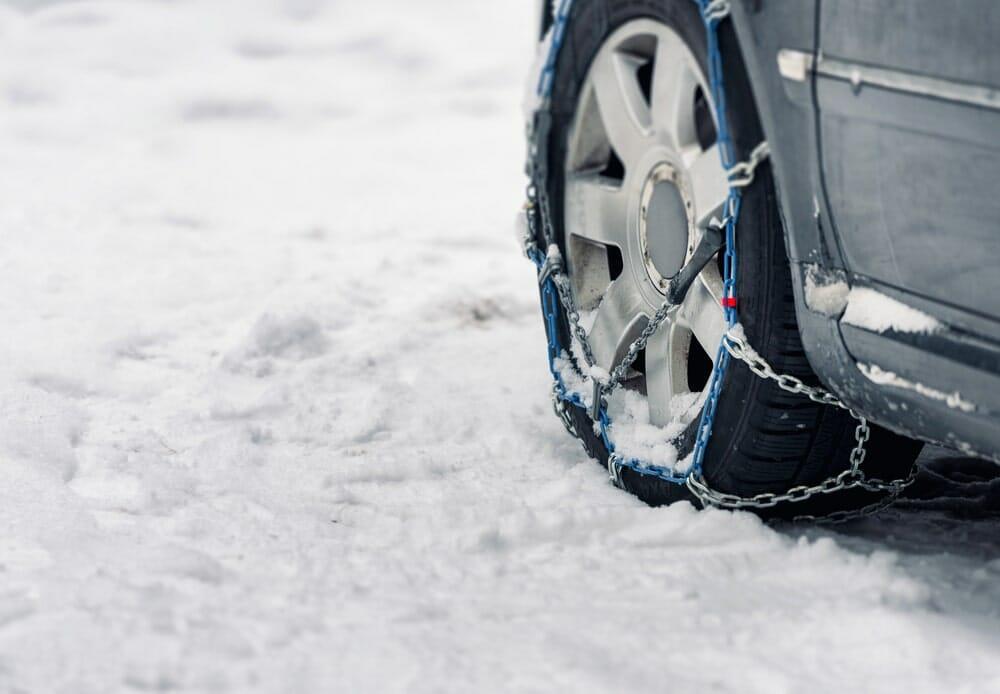Updated on April 22, 2022
Nothing can handle knee-deep snow and ice better than snow chains. Even an offroad 4WD SUV could struggle without them. If you need to move through snow, using snow chains is essential. However, it’s important to understand how fast you can drive with snow chains and the factors that affect your maximum speed. In this article, we’ll explore the functionality of snow chains, their speed limitations, and provide tips for safe driving in snowy conditions.
Table of Contents
What Are Snow Chains and How Do They Work?
Snow chains are a series of chains wrapped around tires to provide better traction in snowy or icy conditions. These chains create additional grip, allowing you to drive through harsh weather with more confidence. They are secured tightly to the tires using hooks, acting as an extension of the tire’s grooves. This reduces the area of contact between the tire and the road, creating more friction. However, it is important to note that snow chains should only be used in extreme weather conditions. Using them on bare asphalt or thin layers of snow can cause damage to both your vehicle and the road.
How Fast Can You Drive With Snow Chains?
When using snow chains, driving at your regular speeds is not possible. Snow chains slow you down significantly, and you should plan your journeys accordingly. On average, you can comfortably cruise at around 20 mph with snow chains. The maximum speed you can reach is about 30 mph. Driving at higher speeds would be risky. Additionally, using snow chains will also affect your car’s fuel economy. Keep in mind that using snow chains increases the risk of damage to your vehicle, reduces your speed, and negatively impacts fuel efficiency. Therefore, only use snow chains when absolutely necessary.
In some states that experience heavy snowfall, using snow chains is mandatory during severe weather conditions. These states also enforce speed limits when snow chains are in use, typically set at 30 mph.
Factors That Affect the Maximum Speed While Using Snow Chains
The maximum speed you can drive with snow chains depends on several factors. While the law may allow speeds of up to 30 mph, adverse conditions may require you to drive even slower. Consider the following factors:
Visibility
Driving at high speeds when visibility is low is dangerous. Snowy conditions often impair visibility, and driving slowly in such situations is crucial for safety. If you’re experiencing heavy snowfall, it is recommended to drive as slowly as possible.
Condition of the Snow Chains
Even with snow chains, losing control is still possible. This is especially true if your chains are old, rusted, or have undergone significant wear and tear. It’s important to assess the structural integrity of your chains before driving. If they are not securely fastened or do not fit properly, driving at high speeds can put extra pressure on the chains and potentially cause them to come loose. Adjust your speed accordingly based on the age and condition of your snow chains.
Experience Driving in Snowy Conditions
If you’re new to driving with snow chains, it’s best to drive slowly until you gain confidence and experience. Gradually increase your speed as you become more comfortable. Practice is key when it comes to driving in snowy conditions.
Weather Conditions
Weather conditions greatly impact driving safety. Ice and fresh snow provide less traction, even with snow chains. It’s crucial to assess the road conditions before accelerating. If you encounter icy patches, slow down even further. Ultimately, your judgment and caution should dictate your speed.
Considering these factors, the optimal speed with snow chains, regardless of conditions, is roughly 20 to 25 mph.
How to Properly Use Snow Chains?
Before attaching snow chains to your tires, you must determine which tires to equip. The placement of snow chains depends on the type of car you have. For rear-wheel-drive vehicles, install the chains on the rear wheels. Front-wheel-drive cars require the chains to be fitted on the front wheels. For 4WD cars, snow chains should be used on all four wheels.
Fastening Snow Chains
Attaching snow chains to your tires is a relatively simple process, but it’s important to ensure a proper fit. Purchase snow chains that match your tire size precisely. Lay the chains on the road or driveway, untangled and stretched out. Align your wheels with the chains, positioning them as close to the center as possible. Wrap the chains around the tire and use the hooks or rings provided to secure each end. Ensure that the upper half of the tire is covered and then move the car slightly forward to complete the attachment using the remaining hooks.
Make sure to install snow chains before driving in snowy conditions, preferably in your driveway or on a clear street. Installing them while you’re already stuck in the snow can be more challenging and messy.
Alternatives to Snow Chains
If you prefer not to use snow chains, there are alternative options available. Here are a few alternatives to consider:
Snow Socks
Snow socks function similarly to snow chains. However, instead of metal, they are made of fabric designed to provide optimal grip. Snow socks offer advantages such as lighter weight, easier storage, better control, and no damage to tires or roads. However, they are prone to tearing in tough conditions and have a maximum speed limit of around 25 mph. Some regions do not consider them a sufficient replacement for mandatory snow chains.
Spider Spikes
Spider spikes are a modern alternative to snow chains. They are metal attachments that can be easily fixed to the sides of the wheels. They are quick to set up and convenient to use. However, spider spikes can be expensive, costing $350 and above. In terms of speed, they offer no advantage over snow chains.
Tire Straps
Tire straps, also known as plastic snow chains, are made of plastic and attached to the wheels using straps. Installing tire straps is much easier compared to snow chains and causes minimal to no damage to the wheels. Although they provide slightly less grip, they offer similar speeds to snow chains. However, they tend to be slightly more expensive.
Tire Wraps
Tire wraps feature a fishnet design and are similar to snow socks. They are easy to attach to the tires and handle snowy conditions well. However, they are prone to wear and can easily be damaged when driven on dry road patches. As long as you drive through snow and ice, they serve as a decent alternative.
Snow Tires
Snow tires come in two types: studded and non-studded. Studded tires offer the best traction, even on dry patches. However, they are known to damage roads in dry conditions and are illegal in some states. Studded tires can be expensive and require professional installation. Non-studded snow tires also provide excellent traction, and they can handle various road conditions effectively. Snow tires allow for speeds of up to 40 mph.
Consider the weather conditions and your specific needs when selecting an alternative to snow chains. Snow tires are a great investment if you frequently encounter heavy snow, while other alternatives provide viable options with their own advantages and limitations.
Tips for Safely Driving in Snowy Conditions

Winter brings snowy and icy roads, which can be challenging to navigate. While snow chains provide added protection, it’s important to follow other practices for safe driving in these conditions. Here are some tips:
Drive Slowly
Driving at a reduced speed is crucial in snowy conditions. Even though 30 mph is the maximum speed with snow chains, it’s advisable to stay around 20 mph or lower if you lack experience. Unlike on clear roads, it takes much longer to come to a stop on snowy surfaces. Driving slightly slower ensures a safer driving experience. If you notice excessive swaying or drifting while taking turns, it indicates that you’re going too fast. Ease off the gas pedal and maintain a safe speed. Even experienced drivers should avoid exceeding 30 mph when using snow chains.
Avoid Slamming the Brakes
A common mistake is slamming the brakes, which can cause your car to slide and lose control. Instead, apply gentle and gradual pressure to decrease your vehicle’s speed.
Maintain a Safe Distance
Increase the distance between your vehicle and the one ahead. Braking distances increase significantly in icy and snowy conditions. If you’re tailgating, you risk crashing into the vehicle in front, especially if they suddenly slow down. Overtaking is not advisable unless the vehicle you’re passing is driving excessively slowly (below 15 mph).
Learn How to Handle a Slide
Even with caution, slides can occur on slippery surfaces. If you find yourself in a slide, turn your wheels in the direction you want to go. Research and practice techniques for handling slides to ensure you respond correctly.
Stay Focused
Snowy conditions require constant attention and awareness. Avoid relying on your subconscious driving habits and remind yourself of the conditions you’re driving in. Be aware of your surroundings and slow down when necessary.
Driving through snow and ice always carries some level of risk. By following these tips and using proper equipment like snow chains or alternatives, you can significantly reduce the chances of accidents and ensure a safer journey.
Frequently Asked Questions (FAQs)
Here are some common questions regarding snow chains:
How much do snow chains cost?
The cost of snow chains varies depending on the type and size. Basic snow chains can be as affordable as $30, while high-end options with additional features can cost $300 or more. Larger truck tires may require more expensive chains.
How should I drive with snow chains?
When driving with snow chains, it is important to drive at a slow and cautious speed. Keep your speed under 25 mph, ensuring that the chains are properly fastened to your tires. By adhering to these guidelines, driving with snow chains becomes manageable.
Can snow chains damage wheels?
There is a possibility of snow chains damaging your tires if not used correctly. Proper usage involves driving through ice and snow only. Driving over dry patches can harm both your tires and the road. Ensure your chains are securely fastened to minimize the risk of damage.
Are snow chains necessary?
The necessity of using snow chains depends on the weather conditions and the road you’re driving on. If you’re planning to drive through snow or ice, snow chains are a must. However, they should not be used on bare asphalt or in thin layers of snow. Local regulations and seasonal weather conditions will determine when snow chains become mandatory.
What happens if you exceed the speed limit with snow chains?
Exceeding the recommended speed limit of 30 mph with snow chains can lead to loss of control or even tire damage. Overspeeding with snow chains is not only dangerous but also considered a violation of the law in many states, resulting in fines.
What is the best alternative to snow chains?
Several alternatives to snow chains exist, with each possessing its own pros and cons. Tire straps, tire socks, and tire wraps are viable alternatives that offer comparable speeds and ease of installation. Snow tires provide excellent traction and can handle treacherous road conditions at speeds up to 40 mph.
In conclusion, snow chains are an essential tool for traversing snowy terrain. While they limit your speed to a maximum of 30 mph, they are able to provide the necessary traction in adverse conditions. Proper installation and adherence to safe driving practices are key to ensuring a smooth and secure journey. Remember to drive slowly, avoid sudden braking, and keep a safe distance from other vehicles. By using snow chains or alternative options, you can confidently navigate through snowy roads with reduced risk.
For more related articles, visit 5 WS.



